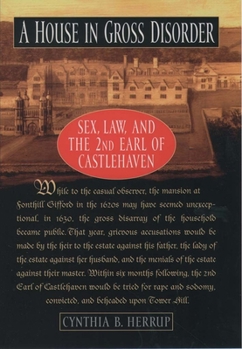A House in Gross Disorder: Sex, Law, and the 2nd Earl of Castlehaven
Select Format
Select Condition 
Book Overview
Sex, privilege, corruption, and revenge--these are elements that we expect to find splashed across today's tabloid headlines. But 17th century England saw a sex scandal that brought disgrace to the ruling class and ended with the beheading of an earl. In A House in Gross Disorder, Cynthia Herrup presents a strikingly new interpretation of the case of the 2nd Earl of Castlehaven and of the sexual and social anxieties it cast into such bold relief. Castlehaven was convicted of assisting in the rape of his own wife and of committing sodomy with his servants. But more than that, he stood accused of inverting the natural order of his household by reveling in rather than restraining the intemperate passions of those he was expected to rule and protect. Herrup argues that because an orderly house was considered both an example and endorsement of aristocratic governance, the riotousness presided over by Castlehaven was the most damning evidence against him. Avoiding simple conclusions about guilt or innocence, Herrup focuses instead on the fascinating legal, social and political dynamics of the case and its subsequent retellings. In riveting prose, she reconsiders a scandal that still speaks to contemporary anxieties about sex, good governance, and the role of law in regulating both.
Format:Paperback
Language:English
ISBN:0195139259
ISBN13:9780195139259
Release Date:March 2001
Publisher:Oxford University Press
Length:232 Pages
Weight:0.68 lbs.
Dimensions:0.6" x 5.5" x 8.5"
Related Subjects
17th Century Birdwatching Courts England Europe History Judicial System Law Legal History Legal Theory & SystemsCustomer Reviews
2 ratings
Excellent
Published by Thriftbooks.com User , 19 years ago
A nice and satisfying read. Herrup combined a truly impressive amount of primary sources, scattered over 10 different archives and libraries. Instead of drowning in the source material and the vast body of secondary literature, she offers a nice, crisp and concise 150+ page analysis. All the raunchy details of the Castlehaven case are there, but the supposed escapades of the Second Earl of Castlehaven are not the prime focus of this book. Through the relatively restricted prism of a scandalous lawsuit, Herrup achieves in painting a surprisingly broad and kaleidoscopical image of civil society in the mid-17th-century Britain. She skillfully treat themes such as the relations between men and wives, the official and actual perceptions of catholics and Irish, the delicate position of King Charles I and the strife at the royal court between old nobility and the recently ennobled. Herrup carefully avoids any references to the marquis De Sade. It's easy to see why. Inclusion of De Sade would probably have broadened the scope of the book too much: times, country and circumstances were so much different. But still, it's seducing to compare the two. Sade was given a death sentence in 1772, just as Castlehaven 141 years earlier. Both men did not repent, both their wives were of questionable reputation. And the accusations against Earl Mervin could have directly inspired parts of Sade's Philosophy In The Boudoir.
Great story, well-told
Published by Thriftbooks.com User , 24 years ago
I loved this book. The story is unbelievable, and Cynthia Herrup does a great job of explaining all its ins-and-outs (no pun intended). If you want a novel, this ain't it. But if you want a great history book, this is for you. Me? I'm giving it to all my friends . . . and maybe my mom too!






